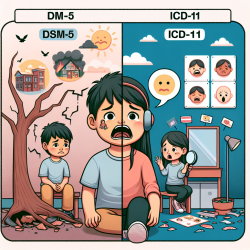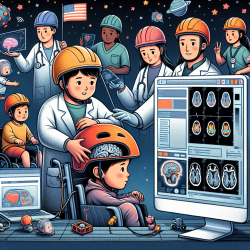Understanding PTSD Models in Preadolescent Children: DSM-5 vs. ICD-11
In the realm of speech-language pathology and child psychology, the accurate diagnosis and treatment of post-traumatic stress disorder (PTSD) in children is crucial. Recent research by La Greca, Danzi, and Chan (2017) sheds light on how DSM-5 and ICD-11 models compare in diagnosing PTSD among preadolescent children exposed to natural disasters. This blog explores the findings of their study and its implications for practitioners working with trauma-exposed children.
Research Overview
The study analyzed data from children aged 7-11 who were affected by Hurricane Ike. The researchers aimed to evaluate how well the DSM-5 and ICD-11 models fit the PTSD symptoms exhibited by these children. Additionally, they assessed the co-occurrence of anxiety and depression symptoms in children meeting PTSD criteria according to these models.
Key Findings
- Model Fit: The ICD-11 model demonstrated the best fit for the children's symptoms, followed by DSM-IV and DSM-5. This suggests that the ICD-11 model may be more parsimonious and clinically useful for diagnosing PTSD in children.
- Gender Invariance: The ICD-11 model showed strong measurement invariance across gender, meaning it was equally applicable to both boys and girls. In contrast, DSM-5 demonstrated weak invariance, indicating potential gender differences in symptom expression.
- Co-occurring Symptoms: Children meeting DSM-5 criteria exhibited higher levels of depression and anxiety compared to those meeting ICD-11 criteria. This highlights the DSM-5's tendency to identify children with comorbid conditions, necessitating comprehensive clinical interventions.
Implications for Practitioners
For practitioners, these findings underscore the importance of using both DSM-5 and ICD-11 criteria when assessing PTSD in children. Relying solely on one model may overlook significant symptoms and comorbidities. The DSM-5 model's ability to identify children with co-occurring anxiety and depression suggests that interventions should address these additional symptoms to improve outcomes.
Moreover, the strong fit of the ICD-11 model indicates its potential for simplifying the diagnostic process, making it a valuable tool for clinicians. However, practitioners should remain vigilant about the limitations of each model and consider comprehensive assessments that encompass elements from both DSM-5 and ICD-11.
Encouraging Further Research
While this study provides valuable insights, further research is needed to refine PTSD diagnostic models for children. Future studies should explore the applicability of these models to other trauma types, such as maltreatment or medical injuries. Additionally, investigating the long-term outcomes of children diagnosed using these models can enhance our understanding of PTSD's impact on child development.
To read the original research paper, please follow this link: DSM-5 and ICD-11 as competing models of PTSD in preadolescent children exposed to a natural disaster: assessing validity and co-occurring symptomatology.










